DIE CASTINGS
Die casting are produced
by forcing molten metal under pressure into metal mold casting in
that called dies casting is closely related to permanent mold casting in
that in both processes reusable metal molds are processes differ in
mold filling method. Here as mold filling in permanent
molds casting depends on the force of gravity, die casting involves metal
flow at high velocities induced by the Applicaiton of pressure. Because of
this high velocity we, die casting can produce shapes that are more
complex than shapes that can be produced by permanent mold casting.
In die casting, after
the die has been closed and locked, molten metal is delivered to a pump/
plunger. The pump plunger is advanced to drive the metal quickly through the
feeding system
While the air in the die escapes through vents. Sufficient metal is introduced to over flow the die cavities, fill overflow wells and develop some flash. As the extraneous metal solidifies, pressure is applied to the remaining metal and is maintained through specified dwell time to allow the casting to solidify. The die opens and the casting is then ejected. While the casting die is open, it is cleaned and lubricated as required. Then the die is closed and locked, and the cycle is repeated.
Advantages of die casting process
• More complex shapes can be made by die casting than by permanent mould casting.
• Because the dies are filled by
pressure, casting with thinner walls, greater length-to-thickness ratio, and
greater dimensional accuracy can be produced by die casting than by most other
casting process
• Production rates are higher in die
casting, especially when multiple –cavity dies are used, than in other casting
processes.
• Because die
casting are produced as almost completely finished parts, the investment in
inventory and factory floor space is reduced to a minimum.
• Dies
for die casting (like moulds for permanent mould casting) can produced many
thousands of castings without significant change die casting dimensions.
• Metal cost is often lower than in
other casting processes, because die casting permits casting of thinner
sections.
• Some
aluminum alloy die castings can develop higher strength than comparable sand
castings.
Limitations of Die Casting Process
Casting
size is limited, casting weight seldom exceeds 20 Kgs. normally is less
than 4 Kgs. Depending on casting countered and gating,
difficulty may be encountered with air entrapped in the die. Entrapped air
is a principal abuse of porosity. The facilities, consisting
of the machine, the auxiliary equipment and dies are relatively expensive.
Because the die castings are small, large quantities of castings are
required for the process to be economical. With few exceptions, commercial
use of the process is limited to metals having melting temperatures no
higher than those of the copper-based Alloys.
Type of Machine
All die casting machine have one of two different metal- pumping system.
-
Hot chamber system
- Cold chamber
system
If the metal being cast melts at low temp. and thus does not attack the injection -pump material the pump can be placed directly in the molten metal bath (hot chamber machine) if the molten metal attacks the pump material at casting temp. the pump must not be placed in the metal bath and a cold chamber machine must be used.
(1). Hot chamber machine
The metal pumping system is which consists essentially of pressure and power cylinders plunger good-neck and nozzle is typical hot system the good-neck containing the presser cylinder and plunger is submerged in the molten metal bath this arrangement allows the metal to be injected in to the die cavities in minimum time and with minimum decrease in the temp. hot chamber die casting machine are used mainly for casting machine are used mainly for casting of melting metal such as zinc-tin and lead alloys.
(2). Cold chamber system
In a cold- chamber machine, the shot chamber is unheard except for the heat from molten metal ladle into fore casting and plunger tip is water cooled to pouring of the short chamber mounted horizontal with a pouring hole in the top of the chamber wall.
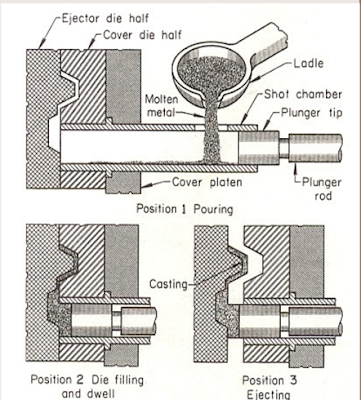 |
| Cold_chamber_Machines |
Advantage of cold-chamber machine
The main
advantages with col-chamber machine are the relative freedom from attack of
molten metal an equipment because the short chamber and plunger are not
submerged in the molten metal meal and high injection pressure range from 8000
to 90,000 psi pressure to 50,000 psi, have been in special or experimental
application.
The main disadvantages with cold- chamber machines are.
- The need for an auxiliary method of feeding metal
- Longer cycle time than is needed for hot-chamber operation.
- The possibility of metal defects due to loss of superheat.
- There is chance of Porosity due to entrapped air in Shot Sleeve while carrying molten material from furnace.
The volume of metal needed for the shot determines shot-chamber
and plunger tip sizes. If the shot chamber is too large, the metal will lie in
the bottom of the chamber and the chances of air entrapment are increased. If
the shot chamber is too small, there will be insufficient metal for the casting
or metal will splash out of the pouring hole. When the machine is being set up,
the plunger tip should be adjusted so that it will immediately start covering
the plunger hole as the plunger advances. In most operations, the actuating
system is such that the plunger is advanced slowly until the pouring hole is
covered and the plunger then moves rapidly to inject metal into the die.
Optimum plunger speed varies with the alloy being cast, the size and shape of
the casting and the design of the gate and runner. Plunger speed range from 150
to 900 ft. per min.
Operation cycle of a vertical cold-chamber Die Casting Machine with sprue bushing.
A vertical cold chamber die casting machine with vertical parting die is shown in Fig. The injection system includes a vertical shot chamber connected directly to the corner die half by sprue bushing. A hydrolytically actuated lower plunger covers the bushing hole in the vertical cold chamber. While metal is being ladled into the chamber from above (position 1). After the metal has been ladled, the upper or shot, plunger is actuated. As the pressure builds up, the lower plunger retracts so that metal is force through the sprue bushing into the.
Operation cycle of a vertical cold-chamber Die Casting Machine with sprue bushing
After a
dwell cycle for metal solidification, the upper plunger is withdrawn, while the
lower plunger is rises & shears of the remaining slug of metal
One disadvantage of this type of machine is that, in having two operating plungers, one of which doubles as a trimmer, it requires frequent maintenance work
Injection Pressure Systems
The pressure used in injection (shot) systems is generated either in air cylinders or in hydraulic cylinders. A hydraulic pressure system usually includes a positive vane- type pump and a gas-oil accumulator as shown in fig.4. The gas-oil accumulator is a pressure vessel that supplies the required volume of oil at the high pressure and rates necessary to fill the mould cavity rapidly with molten metal. An accumulator permits the use of a smaller pump: when an accumulator is used, the volume capacity of pump need only be sufficient to recharge the accumulator between casting cycles.
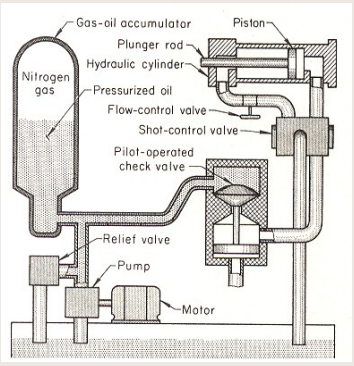 |
| Injection_Pressure_Systems |
Die Locking Mechanism
The most common locking system is shown in this figure. In
comprising a hydraulic-cylinder stroke and dual toggle action, this system
combines the stroke and power transmitted by a hydraulic cylinder with the
mechanical advantage of the link system. The locking action begins when the two
faces of the die come in contact and compression at the dir faces is fist
established. When the three outer link pins are aligned and the crosshead-link
position is normal to the alignment of the pins, maximum force on the die
equals tensile forces in the tie rods.
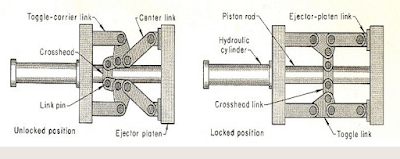 |
| Die_Locking_Mechanism |
Ejection Systems
Die casting dies usually include an integral Systems for ejecting the casting by machine action. When the die is closed, ejector pins contacts the casting and safety (return) pins contacts the parting-line face of the casting fixed half of the die. Both sets of pins are secured in a movable ejector plate assembly. After the die opens, the casting is ejected by the forward movement of the ejector-pin plate. The force required to activate the ejection system may be furnished by mechanical knockout plate, a rack and pinion or a hydraulic cylinder.
 | |
| Ejection_Systems |
Machine
selection for making any casting should be based principally on clamping force
and operating stroke, length of shot stroke, mailshot pressure, maxi. die
opening and die size, max. & min. die height, clearance between beams,
over-all size and cost.
The
rule of thumb for selection of die casting machine size is to use the smallest
machine that will do the job. This will ensure fundamental economy of operation, since the larger the machine, the slower its cycle. For example
400-ton machine can cycle about twice as fustian 800-ton machine. Clamping force
is not necessary the deciding factor n the selection of die a casting machine.
Die dimensions must be considered. The machine adequate tonnage for casting a
part may have insufficient platen area or tie-rod spacing for the die or the
opening stroke may not be sufficient for removal of casting
Another
factor is the cost of the equipment, which must be amortized in the
cost of operation. The cost of auxiliary equipment for die casting machine is
usually proportionate with the size of the machine.
 |
| Specification_of_HMT_die casting_machines |
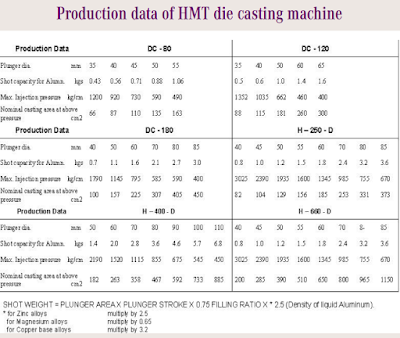 |
| Production_data_of_HMT_die_casting_machine |
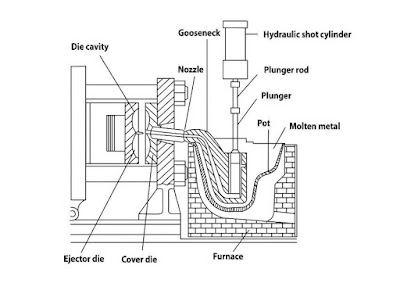







For more information, please comment here. ConversionConversion EmoticonEmoticon